
The Ford Taurus is an automobile that was manufactured by the Ford Motor Company in the United States from the 1986 to 2019 model years. Introduced in late 1985 for the 1986 model year, six generations were produced over 34 years; a brief hiatus was undertaken between 2006 and 2007. From the 1986 to 2009 model years, the Taurus was sold alongside its near-twin, the Mercury Sable; four generations of the high-performance Ford Taurus SHO were produced. The Taurus also served as the basis for the first-ever front-wheel-drive Lincoln Continental (1988–2002).
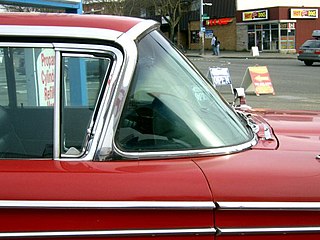
The windshield or windscreen of an aircraft, car, bus, motorbike, truck, train, boat or streetcar is the front window, which provides visibility while protecting occupants from the elements. Modern windshields are generally made of laminated safety glass, a type of treated glass, which consists of, typically, two curved sheets of glass with a plastic layer laminated between them for safety, and bonded into the window frame.
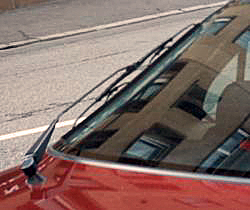
A windscreen wiper or windshield wiper is a device used to remove rain, snow, ice, washer fluid, water, or debris from a vehicle's front window. Almost all motor vehicles, including cars, trucks, buses, train locomotives, and watercraft with a cabin—and some aircraft—are equipped with one or more such wipers, which are usually a legal requirement.
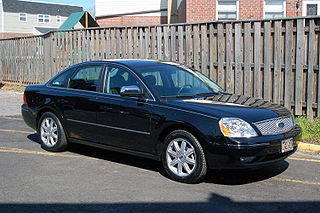
The Ford Five Hundred is a full-size automobile that was manufactured and marketed by Ford from 2004 to 2007, and debuted as a 2005 model year vehicle. Deriving its nameplate from the ''500" suffix used by Ford on the Custom 500, Fairlane 500 and Galaxie 500 model ranges from the 1950s to 1970s, the Five Hundred was the larger of two model lines intended to replace the Ford Taurus. Within the Ford model line, the Five Hundred was slotted between the Fusion and Crown Victoria.
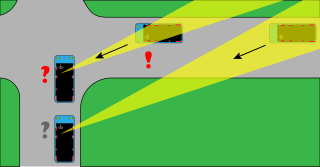
A blind spot in a vehicle or vehicle blind spot is an area around the vehicle that cannot be directly seen by the driver while at the controls, under existing circumstances. In transport, driver visibility is the maximum distance at which the driver of a vehicle can see and identify prominent objects around the vehicle. Visibility is primarily determined by weather conditions and by a vehicle's design. The parts of a vehicle that influence visibility include the windshield, the dashboard and the pillars. Good driver visibility is essential to safe road traffic.

Merkur is a defunct automobile brand that was marketed by the Lincoln-Mercury division of Ford Motor Company from 1985 to 1989. Drawing its name from the German word for Mercury, Merkur was targeted at buyers of European executive cars in North America, selling captive imports produced by the German division of Ford of Europe.
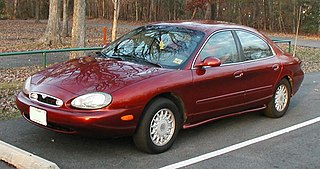
The Mercury Sable is a range of automobiles manufactured and marketed by the Mercury brand of Ford Motor Company. Introduced on December 26, 1985, as the replacement for the Mercury Marquis, the Sable marked the transition of the mid-size Mercury product range to front-wheel drive.
A window film, sometimes called tint, is a thin laminate film that can be installed on the interior or exterior of glass surfaces in automobiles and boats, and as well as on the interior or exterior of glass in homes and buildings. It is usually made from polyethylene terephthalate (PET), a thermoplastic polymer resin of the polyester family, due to its clarity, tensile strength, dimensional stability, and ability to accept a variety of surface-applied or embedded treatments.

The Ford Taurus SHO is the high-performance variant of the Ford Taurus. Originally intended as a limited-production model, the SHO would be produced for the first three generations of the model line, from the 1989 to the 1999 model years. After an 11-year hiatus, the model was revived for 2010, continuing through the 2019 discontinuation of the Taurus model line.
The AXOD was a 4-speed automatic transaxle for transverse front wheel drive automobiles from the Ford Motor Company. It was introduced in the 1986 Ford Taurus/Mercury Sable. The AXOD and its successors are built in Ford's Van Dyke Transmission plant in Sterling Heights, Michigan. Production of the final member of the family, the 4F50N, ended in November 2006.

In aeronautics, ice protection systems keep atmospheric moisture from accumulating on aircraft surfaces, such as wings, propellers, rotor blades, engine intakes, and environmental control intakes. Ice buildup can change the shape of airfoils and flight control surfaces, degrading control and handling characteristics as well as performance. An anti-icing, de-icing, or ice protection system either prevents formation of ice, or enables the aircraft to shed the ice before it becomes dangerous.

Windshield washer fluid is a fluid for motor vehicles that is used in cleaning the windshield with the windshield wiper while the vehicle is being driven.

Tempered or toughened glass is a type of safety glass processed by controlled thermal or chemical treatments to increase its strength compared with normal glass. Tempering puts the outer surfaces into compression and the interior into tension. Such stresses cause the glass, when broken, to shatter into small granular chunks instead of splintering into jagged shards as ordinary annealed glass does. The granular chunks are less likely to cause injury.

The Ford Crown Victoria Police Interceptor is a four-door, body-on-frame sedan that was manufactured by Ford from 1992 to 2011. It is the police car version of the Ford Crown Victoria and was the first vehicle to use the Ford Police Interceptor name.
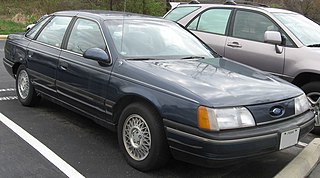
The first-generation Ford Taurus and Mercury Sable are automobiles produced by Ford as the first of six generations of the Ford Taurus and Mercury Sable. Launched on December 26, 1985, as a 1986 model, the front-wheel-drive Taurus was a very influential design that is credited with saving Ford from bankruptcy, bringing many innovations to the marketplace and starting the trend towards aerodynamic design for the American automakers in the North American market. Ford of Europe had launched the 1980s move to aerodynamic design for the company with the 1982 Ford Sierra.

The third-generation Ford Taurus is an automobile that was marketed by Ford from the 1996 to 1999 model years. While the chassis underpinnings were largely carried over, the redesign gave the Taurus its first complete exterior redesign since its 1986 introduction. Slotted between the compact Ford Contour and full-size Ford Crown Victoria, the third-generation Taurus was again offered as a four-door sedan and as a five-door station wagon, marketed alongside the Mercury Sable.
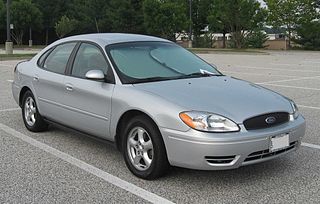
The fourth-generation Ford Taurus is an automobile that was produced by Ford for the 2000 to 2005 model years. While mechanically similar to its 1996-1999 predecessor, major revisions to the bodyshell of the sedan were done to alter its controversial styling as well as add interior room; it was available in four-door sedan and five-door station wagon models.

The sixth generation of the Ford Taurus is the final generation of the model range manufactured by Ford. Introduced for the 2010 model year, the sixth-generation Taurus is the second generation of the model line produced as a full-size car; it was the heaviest sedan sold under the Ford brand worldwide. While sharing its D3 chassis underpinnings with the previous generation, the sixth generation marked the first North American use of Kinetic Design design language.
Heated glass is a resistance heater created when a transparent, electrically conductive coating is applied to float glass and then subjected to an electric current. The electric current in the coating creates heat energy, which warms the glass until the glass radiates heat.
Aquila Racing Cars is a race car manufacturer from Denmark.















